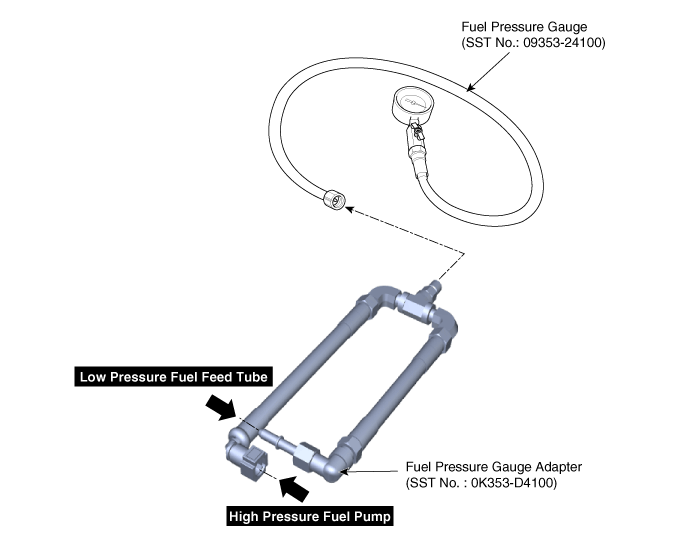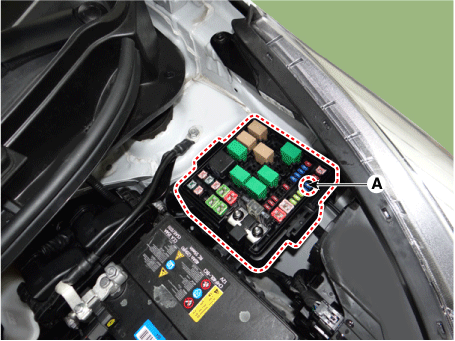Kia Picanto: Engine Control / Fuel System / Fuel Delivery System
Kia Picanto JA 2017-2025 Service & Repair Manual / Engine Control / Fuel System / Fuel Delivery System
Components and components location
| Components Location |
| Fuel Tank & Filler-Neck Assembly |
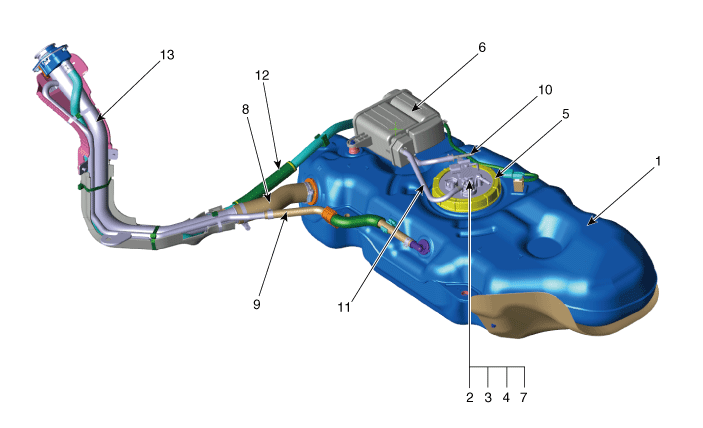
| 1. Fuel Tank 2. Fuel Pump 3 Fuel Filter 4. Fuel Pressure Regulator 5. Fuel Pump Plate Cover 6. Canister 7. Fuel Level Sender | 8. Fuel Filler Hose 9. Leveling Hose 10. Vaper Hose (Canister → Intake Manifold) 11. Vaper Hose (Canister → Fuel Tank) 12. Vapor Hose (Canister → Atmosphere) 13. Filler-Neck Assembly |
| Fuel Pump |
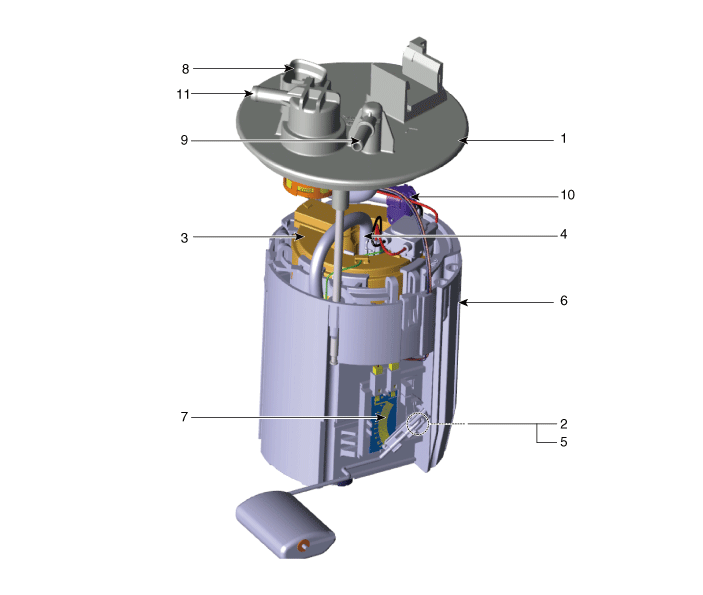
| 1. Head Assembly 2. Fuel Pressure Regulator 3. Fuel Filter 4. Fuel Pump Motor 5. Fre-Filter 6. Reservoir Cup | 7. Fuel Sender 8. Fuel Pump Motor & Fuel Sender Connector 9. Fuel Feed Port 10. Fuel Feed Tube 11. Vapor Port |
Schematic diagrams
| Schematic Diagrams |
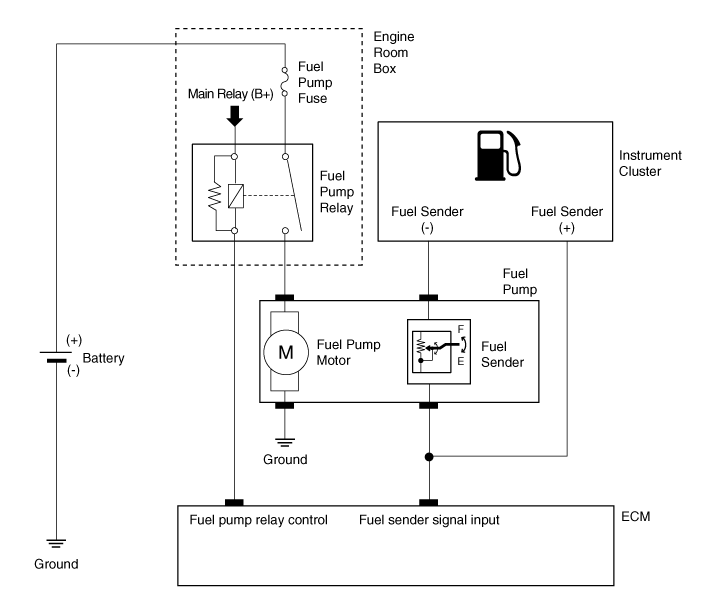
Fuel pressure test (low pressure system)
| Fuel Pressure Test |
| 1. | Release the residual pressure in fuel line.
(Refer to Delivery System - “Release Residual Pressure in Fuel Line”)
|
| 2. | Install the Special Service Tool (SST).
|
| 3. | Inspect fuel leakage on connections along the fuel feed tube, the delivery pipe, and the SST components with IG ON. |
| 4. | Measure Fuel Pressure.
|
| 5. | Release the residual pressure in fuel line.
(Refer to Delivery System - “Release Residual Pressure in Fuel Line”)
|
| 6. | Test End
|
Release residual pressure in fuel line
| Release Residual Pressure in Fuel Line |
Whenever
the high pressure fuel fuse, fuel pipe, delivery pipe, or injector is
removed immediately after shutting off the engine, an injury may be
caused by the release of highly pressurized fuel. Release the residual
pressure in the high pressure fuel line by referring to the "Residual
fuel pressure release procedure" below before removing any high pressure
fuel system components. |
Wear safety glasses and fuel resistant gloves. |
| 1. | Turn the ignition off and disconnect the battery negative cable. |
| 2. | Remove the fuel pump fuse (A).
|
| 3. | Reconnect the battery negative terminal. |
| 4. | Run the engine for about 1 minute to lower the pressure in the low pressure line. |
| 5. | Turn off the engine. |
| 6. | Disconnect
the low pressure fuel line quick connector at the High Pressure Pump.
Use rags to cover opening and catch spills while removing the fuel line.
|
| 7. | Start the engine and let it idle until the engine stops. At this point the pressure should be under 30 psi. |
| 8. | Proceed with the service or repair. Use rags to cover opening and catch spills when opening up the high pressure system. |
| 9. | Reinstall
/ re-connect all components in reverse order of removal. Start engine
and confirm proper operation, and make sure there are no fuel leaks. |
| 10. | After completing, clear DTC(s) using KDS scan tool (the procedure described above will cause DTC to set). |
- Fuel Tank
- Fuel Pump
- Fuel Filter
- Fuel Sender
- Fuel Pump Motor
- Fuel Pressure Regulator
- Fuel Line
- Filler-Neck Assembly
- Delivery Pipe
- High Pressure Fuel Pump
 Clutch switch
Clutch switch
Specifications
Specifications
Item
Specifications
Working voltage DC 12.5V Operating force Initial position : 0.25 ± 0.15 N ...
 Fuel Tank
Fuel Tank
Specifications
Specification
Items
Specification
Fuel Tank Capacity (L) 35 L (9.24 U.S. gal, 37.0 U.S. qt, 30.8 lmp. qt.)
...
Other information:
Kia Picanto JA 2017-2025 Service & Repair Manual: Rear Glass Defogger Switch
Repair procedures Inspection 1.In the body electrical system, failure can be quickly diagnosed by using the vehicle diagnostic system (KDS/GDS).The diagnostic system (KDS/GDS) provides the following information.(1)Self diagnosis : Checking failure and code number (DTC)(2) Current data : Checki ...
Kia Picanto JA 2017-2025 Service & Repair Manual: Curtain Airbag (CAB) Module
Description and operation Description Curtain airbags are installed inside the headliner (LH and RH) and protect the driver and passenger from danger when side crash occurs. The SRSCM determines deployment of curtain airbag by using side impact sensor (SIS) signal. & ...
Copyright © www.kpicanto.com 2017-2025



